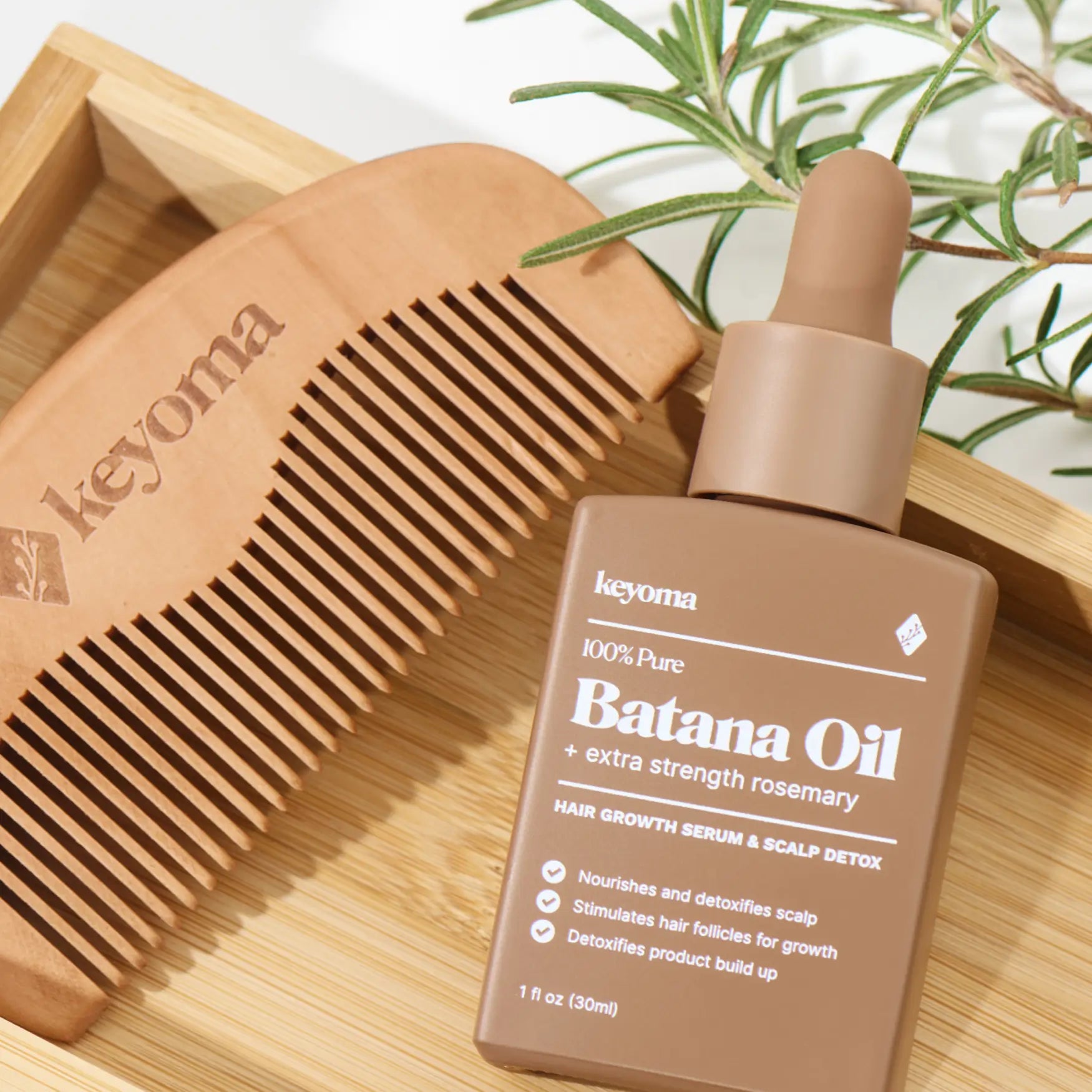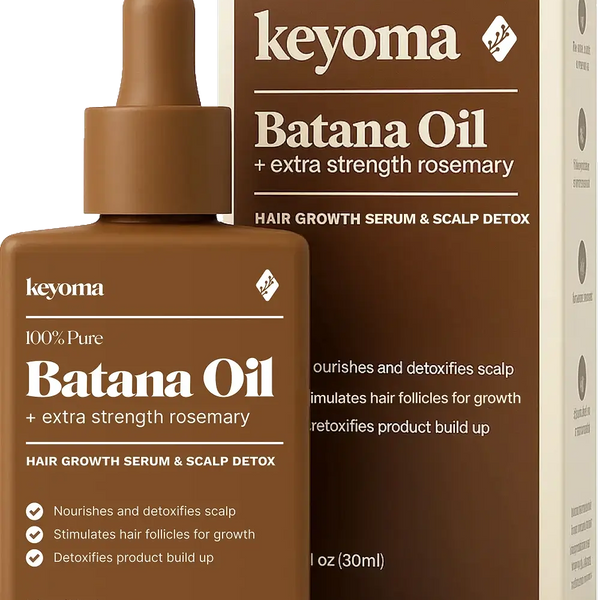In this article
Most people think caring for their hair starts with conditioner, but the truth is, it starts a few inches higher, right on your scalp. That’s because scalp care isn’t the same as hair care.
While one deals with what you see—your strands, your shine, your split ends—the other focuses on the vital skin underneath that ultimately decides how healthy your hair actually grows.
In this guide, we’ll go over what a good scalp care routine looks like and how to tailor it to your scalp type so every new strand grows stronger from the start.
Scalp Care vs Hair Care
Although the two might sound similar—and they often get used interchangeably—they’re actually quite different, mainly in what they target.
Hair care focuses on the strands themselves. It involves conditioning, styling, and repairing visible damage such as dryness, split ends, or color fade.
Scalp care, on the other hand, focuses on the skin underneath. It involves cleansing away buildup, balancing oil production, and keeping follicles clear and nourished. It’s what maintains the environment where new, healthy hair can actually grow.
In that sense, scalp care isn’t separate from hair care. It’s a vital part of it—because you can’t have healthy hair without a healthy scalp.
When buildup, excess oil, or inflammation sit on the scalp, it throws everything off balance and eventually leads to dandruff, itchiness, and even shedding.
All that said, caring for your scalp first is what makes every conditioner, mask, and serum actually work.
Signs Your Scalp Needs Extra Care
Persistent Itching or Tingling
When you constantly feel the urge to scratch, that usually points to irritation or an imbalance in the scalp’s natural ecosystem. It can come from excess sebum, leftover styling products, or even a disrupted scalp microbiome.
If left ignored, scratching can inflame follicles, slow down growth, and sometimes lead to small wounds that invite bacteria or fungus.
Visible Flakes or Build‑Up
Flakes don’t always mean dandruff. Sometimes they’re just dry skin or product residue clogging follicles.
Either way, buildup suffocates roots and blocks oxygen flow. When follicles can’t breathe, they grow weaker strands that shed easily.
Oily Scalp After a Day or Two
If your hair feels greasy less than 24 hours after washing, it’s a sign your scalp’s oil glands are overactive. This can happen when harsh shampoos strip natural oils, prompting the skin to produce even more sebum in defense.
Over time, the excess oil attracts dirt and yeast, which can trigger inflammation or seborrheic dermatitis.
Tenderness or Soreness
A sore scalp often shows up after tight hairstyles, buildup, or inflammation deep in the follicle. That tenderness means your skin barrier is compromised. Leave it unaddressed and you risk traction injury or folliculitis, which show up as tiny inflamed bumps around hair roots.
Slower Growth or Excess Shedding
When your scalp environment becomes unbalanced—whether too oily, too dry, or inflamed—your hair’s growth cycle starts to shorten. Follicles spend more time resting and less time growing, which eventually leads to new strands coming in thinner and breaking more easily.
Easy Scalp Care Routine You Can Try At Home
Scalp Care Routine for Dry Scalp
A dry scalp happens when the skin lacks moisture and protective oils. Simply put, it's the dehydration of the skin barrier. It can be triggered by cold weather, overwashing, or harsh shampoos that strip away sebum.
When the scalp barrier weakens, it tightens, flakes, and feels itchy, similar to dry skin anywhere else on your body. So the principle behind this routine is simple: restore moisture while keeping the scalp’s microbiome balanced.
1. Choose a gentle, hydrating shampoo
Use a sulfate‑free or moisturizing formula enriched with aloe vera, glycerin, or coconut‑derived cleansers. These wash away buildup without stripping natural oils.
2. Limit washing frequency
Cleanse two to three times a week, or less if your hair feels comfortable. Washing daily worsens dryness by removing the lipids that seal in moisture.
3. Apply a nourishing scalp oil before washing
Massage batana oil or a rosemary‑infused blend into your scalp 30 minutes before shampooing. This pre‑wash step replenishes lost oils and improves circulation.
4. Condition from mid‑length to scalp ends
Even though conditioners focus on strands, bring a small amount near the scalp to soften flakes and calm tightness. Rinse thoroughly with lukewarm water.
5. Use a lightweight scalp serum after drying
Look for formulas with niacinamide or hyaluronic acid to hydrate and soothe the scalp barrier. Avoid heavy silicones that can suffocate roots.
6. Add weekly care
Once a week, exfoliate gently with a mild scalp scrub or salicylic acid scalp treatment to remove dead cells and allow moisturizers to penetrate better. Follow up with oil or serum for balance.
Scalp Care Routine for Oily Scalp
An oily scalp—the polar opposite of dry scalp—is a sign of overactive sebaceous glands. The scalp naturally produces sebum to protect and hydrate the skin, but when production goes into overdrive, it can trap dirt, clog follicles, and feed yeast overgrowth.
The principle here is to rebalance oil production without stripping away the scalp’s protective barrier.
In other words, you want to cleanse effectively enough to remove excess sebum and buildup, yet keep the natural moisture and microbiome intact so the scalp doesn’t overcompensate by producing even more oil.
1. Pick a balancing or clarifying shampoo
Use a gentle clarifying shampoo formulated with ingredients like salicylic acid, tea tree, or zinc pyrithione. These dissolve oil, remove buildup, and keep the scalp’s microbiome in check.
2. Wash regularly but not excessively
Every other day works best for oily scalps. Washing too often can backfire, as the scalp compensates by producing even more oil. Alternate with a mild, sulfate‑free shampoo on in‑between days if needed.
3. Exfoliate weekly
Once or twice a week, use a scalp exfoliating treatment or scrub to lift dead skin and residue. This keeps follicles open and improves product absorption.
4. Use lightweight hydration
Skip heavy oils and thick masks. Instead, apply a water‑based scalp serum with niacinamide or green tea extract. These ingredients calm inflammation and help normalize sebum activity.
5. Rinse with cool water
Hot water stimulates oil glands and worsens greasiness. Cool or lukewarm rinses tighten pores and refresh the scalp.
6. Mind your lifestyle factors
Oily scalps can also stem from stress, hormonal changes, or high‑glycemic diets. Getting adequate rest and maintaining a balanced diet supports long‑term scalp health.
Scalp Care Routine for Sensitive Scalp
A sensitive scalp is one that reacts easily to even mild triggers, including fragrance, heat, certain ingredients, or friction.
This happens because its protective barrier—the outermost layer of skin—is thinner or weakened.
How does this happen? When the protective barrier loses lipids and moisture, nerve endings sit closer to the surface, and the immune response becomes more alert. That’s why even small amounts of fragrance or heat can cause burning or stinging.
1. Start with a fragrance‑free, hypoallergenic shampoo
Choose formulas labeled for sensitive scalp or baby shampoo varieties. Look for gentle surfactants like cocamidopropyl betaine and calming agents such as oat extract or panthenol.
2. Avoid heat and harsh friction
Wash with lukewarm water and gently massage using fingertips, not nails. Pat dry with a soft towel instead of rubbing to prevent micro‑tears on the skin.
3. Use a barrier‑strengthening serum
A lightweight serum containing niacinamide or ceramides can help reinforce the scalp barrier and reduce reactivity. Apply after drying, focusing on tender or itchy areas.
4. Skip alcohol‑based or strong exfoliants
Sensitive scalps can’t handle salicylic acid scrubs or mentholated formulas. Instead, use mild lactic acid tonics or natural aloe‑based mists to refresh the scalp between washes.
5. Maintain consistent moisture
Dryness worsens sensitivity, so lightly oil the scalp once a week with batana or jojoba oil. Both mimic natural sebum and help calm irritation without clogging pores.
6. Keep styles loose and products minimal
Avoid tight braids, chemical dyes, or heavy layering of products. The fewer ingredients your scalp comes into contact with, the better it can recover.
Scalp Care Dos and Don'ts
Whether your scalp is oily, dry, or sensitive, these dos and don’ts will help you maintain a clean, balanced, and resilient foundation for hair growth.
Dos
-
Wash consistently: Keep a regular cleansing schedule suited to your scalp type to prevent buildup and irritation.
-
Massage gently: Proper scalp massage technique requires using your fingertips to stimulate circulation and loosen debris without scratching the skin.
-
Exfoliate weekly: Remove product residue and dead skin using a mild scalp exfoliant or salicylic acid treatment.
-
Rinse with lukewarm water: Hot water can dry or inflame the scalp. Lukewarm, on the other hand, keeps the barrier comfortable.
-
Choose microbiome‑friendly products: Stick to sulfate‑free, fragrance‑free, or pH‑balanced shampoos and serums that don’t disrupt the scalp ecosystem.
-
Protect from heat and sun: Wear a hat outdoors or apply leave‑in SPF sprays to shield from UV damage.
Don’ts
-
Don't overwash daily: Frequent washing can trigger either dryness or rebound oiliness depending on your scalp type.
-
Don't Use harsh ingredients: Avoid alcohol‑heavy sprays, mentholated scrubs, and strong sulfates that irritate or strip the scalp.
-
Don't ignore flakes or soreness: Persistent itch, tightness, or pain signals imbalance. Address it early with targeted care.
-
Don't pile on products: Layering too many oils, serums, and sprays suffocates follicles and leads to buildup, which is bad for the scalp.
-
Don't tie hair too tight: Repeated tension on the roots can trigger traction alopecia by inflaming follicles and weakening new growth.
Natural Oils to Incorporate Into Your Scalp Care Routine
As mentioned earlier in the routines, lightweight hydration helps restore balance and comfort to any scalp type. And as someone who’s tried plenty of oils myself, these are the ones I recommend starting with.
Batana Oil
Batana oil comes from the American oil palm, traditionally used by the Miskito people of Honduras (nicknamed the People of Beautiful Hair).
It’s rich in oleic and linoleic acids, which strengthen the scalp barrier and deeply moisturize without clogging follicles. Its natural tocopherols (vitamin E compounds) and carotenoids also help repair oxidative damage while calming inflammation.
All of these effects contribute directly to scalp health by restoring elasticity, boosting circulation, and maintaining a nourished environment where follicles can thrive.
Rosemary Oil
Rosemary oil contains ursolic acid and rosmarinic acid, both of which are compounds that stimulate blood flow to follicles and reduce inflammation.
In fact, studies have shown that it can perform comparably to minoxidil in promoting growth while also helping with dandruff and microbial balance.
More importantly, these actions directly support scalp health by improving circulation, reducing microbial buildup, and creating a cleaner, oxygen-rich surface where follicles can thrive. When diluted properly, it can be used for both dry and oily scalps to keep the scalp environment strong and balanced.
Tea Tree Oil
Tea tree oil works as a natural antiseptic and antifungal, making it ideal for scalps prone to dandruff, itch, or mild seborrheic dermatitis. Its key compound, terpinen‑4‑ol, helps reduce yeast overgrowth while soothing irritation.
These combined effects directly support scalp health by reducing inflammation, restoring microbial balance, and keeping the scalp’s surface clean and oxygenated for proper follicle function.
Jojoba Oil
Jojoba oil closely mimics the scalp’s natural sebum, which makes it excellent for restoring balance. It’s non‑comedogenic, meaning it won’t block pores, and it contains vitamins B and E to support overall scalp resilience.
It’s particularly useful for sensitive scalps because of its lightweight, hypoallergenic nature.
Argan Oil
Argan oil, derived from Moroccan argan kernels, is loaded with antioxidants and essential fatty acids. It softens the scalp, helps regulate sebum production, and strengthens follicles through its vitamin E content. It’s especially helpful for dry or damaged scalps and for those who style or color their hair often.
Frequently Asked Questions (FAQs)
How often should I wash my scalp?
You should wash your scalp as often as your scalp type needs, typically every two to three days for most people. However, oily scalps may need more frequent washing, while dry or sensitive ones can benefit from longer gaps between washes.
Do oils clog follicles?
Natural oils like batana, jojoba, or rosemary oil don’t clog follicles when used correctly. In fact, they nourish and lubricate the scalp, helping to loosen flakes and keep follicles clear. Problems arise only when oils are layered excessively or not washed out, which then causes buildup that traps dirt and bacteria.
Can I use salicylic acid on scalp?
Yes, you can use salicylic acid on your scalp, but only in moderate strength and not daily. It works by gently exfoliating dead skin and dissolving sebum plugs that block follicles.
If you have an oily or flaky scalp, you might benefit from using this the most, while those with sensitive scalps should use milder or lactic‑acid‑based alternatives.
A Great Scalp Care Routine Leads to Better Hair Days
To wrap things up, a healthy scalp is the foundation of every strong, shiny strand, and achieving such comes down to three things: keeping it clean to prevent buildup, keeping it balanced to maintain its natural oil and microbiome health, and keeping it nourished so follicles can keep growing stronger over time.
Once those three are in sync, every shampoo, serum, and oil you use works better.
Speaking of oils, they’ve been part of my own scalp care routine for years. My personal favorite is batana oil—lightweight, nutrient‑rich, and perfect as a base for rosemary, peppermint, or other essential oils if you enjoy DIY oil blends.
If you enjoyed this guide, don’t miss out on more free scalp and hair care resources on the Keyoma Blog. You’ll find practical routines, product guides, and evidence‑based tips that help you care for your scalp naturally.
Featured Product
100% Pure Batana Oil + Rosemary









